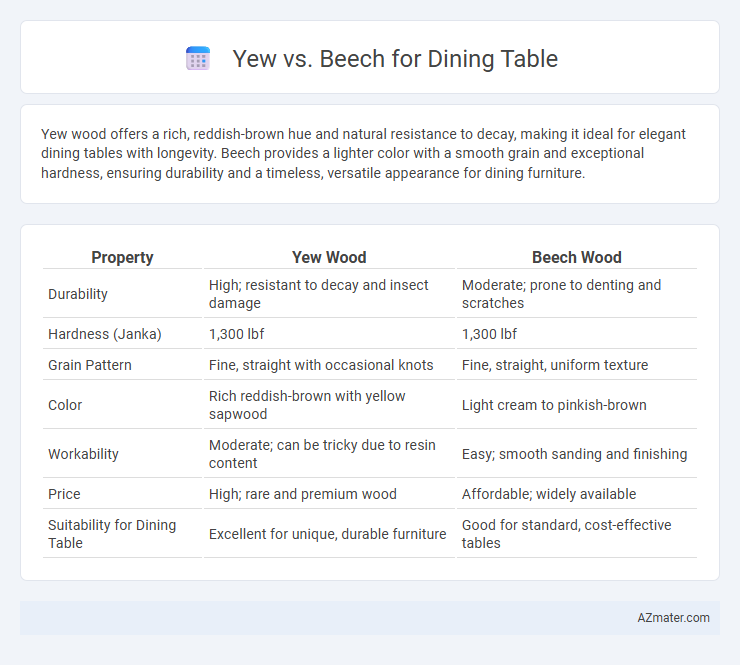Yew wood offers a rich, reddish-brown hue and natural resistance to decay, making it ideal for elegant dining tables with longevity. Beech provides a lighter color with a smooth grain and exceptional hardness, ensuring durability and a timeless, versatile appearance for dining furniture.
Table of Comparison
| Property | Yew Wood | Beech Wood |
|---|---|---|
| Durability | High; resistant to decay and insect damage | Moderate; prone to denting and scratches |
| Hardness (Janka) | 1,300 lbf | 1,300 lbf |
| Grain Pattern | Fine, straight with occasional knots | Fine, straight, uniform texture |
| Color | Rich reddish-brown with yellow sapwood | Light cream to pinkish-brown |
| Workability | Moderate; can be tricky due to resin content | Easy; smooth sanding and finishing |
| Price | High; rare and premium wood | Affordable; widely available |
| Suitability for Dining Table | Excellent for unique, durable furniture | Good for standard, cost-effective tables |
Introduction: Yew vs Beech for Dining Tables
Yew and Beech are both popular hardwood choices for dining tables, valued for their durability and distinctive grain patterns. Yew features rich, warm tones with striking natural grain variations, offering a unique aesthetic appeal, while Beech is known for its uniform, pale color and smooth texture, providing a classic and versatile look. The selection between Yew and Beech depends on desired visual style, hardness, and resistance to wear in dining table applications.
Wood Characteristics: Yew and Beech Comparison
Yew wood features a rich, warm color with natural red and orange hues, offering exceptional durability and resistance to decay, making it ideal for dining tables that require longevity. Beech wood is known for its light, creamy appearance and fine, tight grain, providing a smooth surface and strong resistance to abrasion, which supports everyday use in dining furniture. While Yew is valued for its unique grain patterns and natural oils that enhance water resistance, Beech stands out for its uniform texture and excellent workability, offering distinct aesthetic and functional benefits for dining table construction.
Appearance: Color, Grain, and Aesthetics
Yew wood features a warm, rich yellow to reddish-brown hue with distinct, ornate grain patterns that add a rustic charm to dining tables. Beech wood offers a lighter, creamy pale color with a consistent, fine grain creating a smooth, modern aesthetic ideal for minimalist designs. The choice between Yew's striking, textured appeal and Beech's understated elegance depends on the desired visual impact and interior style of the dining space.
Durability and Strength Analysis
Yew wood offers moderate durability with a Janka hardness rating of around 1,350, providing a balance between strength and flexibility suitable for dining tables subject to everyday use. Beech wood is significantly harder and more durable, boasting a Janka hardness of approximately 1,300 to 1,500, making it resistant to dents, scratches, and general wear over time. The dense fiber structure of beech enhances its load-bearing capacity and longevity, whereas yew's softer grain requires more careful maintenance to prevent surface damage in high-traffic dining environments.
Workability and Crafting Ease
Yew wood offers moderate workability with its fine grain and natural oils, making it relatively easy to carve and shape for dining tables, though its slight brittleness requires careful handling. Beech wood is highly favored for crafting due to its uniform texture and hardness, allowing smooth cutting, sanding, and finishing with minimal effort. Both woods provide durability, but beech's consistent grain and resilience streamline the crafting process, making it a preferred choice for intricate dining table designs.
Maintenance and Care Requirements
Yew wood requires moderate maintenance with regular oiling to retain its rich color and prevent drying or cracking, while Beech demands more frequent sealing to protect its light surface from stains and moisture damage. Both woods benefit from avoiding prolonged exposure to direct sunlight and using coasters to prevent water rings or heat marks. Proper care ensures longevity, with Yew's natural resistance to pests offering an advantage over Beech's susceptibility to dents and scratches.
Environmental Impact and Sustainability
Yew wood, sourced primarily from slow-growing evergreen yew trees, offers a durable and biodegradable option with moderate environmental impact due to its limited commercial harvesting compared to beech. Beech wood, harvested from fast-growing deciduous trees widespread across Europe, supports more sustainable forestry management practices and often comes from certified sources promoting reforestation. Choosing beech for dining tables usually results in a lower carbon footprint and better sustainability metrics, whereas yew may require careful sourcing to ensure minimal ecological disruption.
Price and Availability of Yew and Beech
Yew wood is generally more expensive and less readily available compared to beech, largely due to its slower growth rate and limited supply. Beech is widely accessible and more affordable, making it a popular choice for dining tables in mass production. The price difference can significantly impact budget considerations, with beech offering a cost-effective and durable alternative to the premium appeal of yew.
Best Use Cases and Design Styles
Yew wood, known for its rich grain and natural resistance to moisture, excels in rustic and traditional dining table designs, making it ideal for warm, cozy interiors. Beech offers a smooth, pale finish with durability that suits modern and Scandinavian styles, enhancing minimalist or sleek dining spaces. Both woods provide sturdy surfaces, but yew's distinctive knots contrast with beech's uniform texture, influencing the aesthetic choice based on the desired ambiance.
Conclusion: Which Wood is Better for Your Dining Table?
Yew wood offers a unique combination of rich color and fine grain, providing a warm and elegant look that ages beautifully, while being moderately durable and resistant to wear. Beech wood is highly durable, resistant to dents and scratches, with a light, uniform appearance that brightens dining spaces and stands up well to daily use. Choosing between Yew and Beech depends on the desired aesthetic and durability requirements, with Yew favored for its character and Beech preferred for its toughness and light tone.

Infographic: Yew vs Beech for Dining Table
 azmater.com
azmater.com